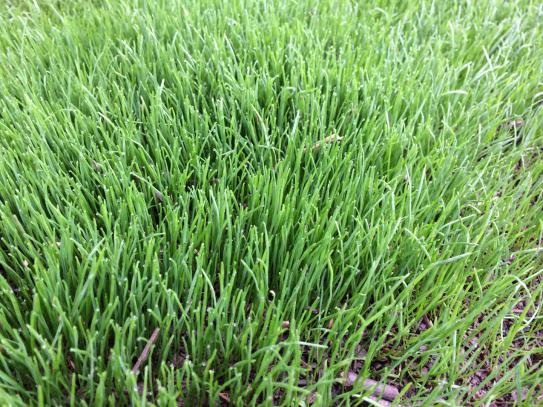Chewings Fescue Grass: The Low-Maintenance, Fine-Textured Lawn for Cool Climates

If you want a lawn that looks lush, feels soft, and doesn’t need constant mowing or fertilizing, Chewings fescue might be exactly what you’re looking for.
This cool-season, fine-leaf grass is a favorite among homeowners who want a natural, low-maintenance lawn that thrives in partial shade and cooler regions.
I’ve seen Chewings fescue used on golf course roughs, park areas, and shaded home lawns across the Northeast and Midwest. It’s one of those grasses that looks beautiful year-round with minimal attention — especially when paired with other fine fescues in a blend.
What Is Chewings Fescue?
Chewings fescue (Festuca rubra ssp. commutata) is part of the fine fescue family — a group that also includes hard fescue, sheep fescue, and creeping red fescue.
Unlike creeping red fescue, which spreads through underground rhizomes, Chewings is a bunch-type grass, meaning it grows in dense clumps. This gives it a velvety, carpet-like appearance that’s ideal for lawns with light to moderate foot traffic.
It’s most at home in cool, moist regions — think New England, the Pacific Northwest, or the northern Great Lakes — and it handles shade far better than most lawn grasses.
Key Benefits of Chewings Fescue
-
Fine, elegant texture: The thin blades create a refined, uniform appearance.
-
Low fertilizer needs: It stays green even in poor soils with minimal feeding.
-
Shade tolerant: Performs well under trees and in partial shade.
-
Drought tolerant: Once established, it requires far less water than bluegrass.
-
Low mowing frequency: Slower growth means less time cutting the lawn.
-
Cold hardy: Recovers well after harsh winters and doesn’t brown easily.
It’s not designed for sports fields or high-traffic areas, but for everyday residential lawns — especially shady ones — it’s hard to beat.
Ideal Growing Conditions
| Condition | Ideal Range | Notes |
|---|---|---|
| Sunlight | Partial shade to 6 hours of sun | Best for areas with mixed light. |
| Soil type | Well-drained, slightly acidic | pH between 5.5 and 6.5 is ideal. |
| Temperature | 60–75°F | Active in spring and fall; slows in summer heat. |
| Watering | 1 inch per week | Deep watering less often is better than frequent light watering. |
| Mowing height | 2.5–4 inches | Taller grass tolerates shade and drought better. |
How to Care for Chewings Fescue
Spring Care
-
Rake away debris and lightly aerate compacted soil.
-
Overseed thin patches at 3–5 lbs per 1,000 sq ft.
-
Apply a light fertilizer (0.25–0.5 lb nitrogen per 1,000 sq ft).
-
Mow to 2.5–3.5 inches.
Summer Care
-
Raise mowing height to 3.5–4 inches to reduce stress.
-
Water deeply once a week if rainfall is limited.
-
Avoid fertilizing during hot weather.
-
Limit traffic if the grass is dormant or dry.
Fall Care
-
This is the main growing season for Chewings fescue.
-
Apply a balanced fertilizer such as 10-10-10 or 16-4-8.
-
Overseed again to maintain density.
-
Continue mowing until growth stops in late fall.
Winter Care
-
Avoid walking on frozen or snow-covered turf.
-
Rake leaves before snow to prevent snow mold.
Common Problems and Fixes
| Problem | Cause | Solution |
|---|---|---|
| Brown patches | Drought dormancy | Water deeply; the grass will recover naturally. |
| Red thread or leaf spot | Low nitrogen or high humidity | Apply light fertilizer; mow only when dry. |
| Thin growth | Compaction or dense shade | Aerate, overseed, and trim tree branches. |
| Scalping | Mowing too low | Maintain a minimum height of 2.5 inches. |
Chewings Fescue vs. Other Cool-Season Grasses
Below is a comparison of Chewings fescue against other popular cool-season turfgrasses used in northern regions.
| Grass Type | Texture | Shade Tolerance | Drought Tolerance | Maintenance Level | Traffic Tolerance | Best Regions |
|---|---|---|---|---|---|---|
| Chewings Fescue | Fine | Excellent | Good | Low | Moderate | Cool, shaded areas (Northeast, Pacific NW) |
| Kentucky Bluegrass | Medium-fine | Fair | Good | Medium-high | High | Full sun lawns in northern U.S. |
| Perennial Ryegrass | Fine | Moderate | Fair | Medium | Moderate-high | Overseeding and fast-germinating areas |
| Tall Fescue | Coarse | Moderate | Excellent | Medium | High | Transitional and mid-Atlantic regions |
| Hard Fescue | Fine | Good | Excellent | Very low | Low-moderate | Northern dry soils and slopes |
| Creeping Red Fescue | Fine | Excellent | Good | Low | Moderate | Cool, coastal, or shaded lawns |
Takeaway:
Among fine fescues, Chewings offers the best mix of shade tolerance, aesthetic quality, and low maintenance.
It’s slower to spread than creeping red fescue but more upright and better for uniform turf.
Recommended Seed Blends
Most experts recommend using Chewings fescue as part of a seed blend. Here are common ratios used by turf managers:
| Blend Type | Chewings Fescue | Hard Fescue | Creeping Red Fescue |
|---|---|---|---|
| Shade mix | 40% | 20% | 40% |
| Sun mix | 30% | 50% | 20% |
| Low-input mix | 50% | 30% | 20% |
Cultivars such as SR 5130, Banner II, Ambrose, and Radar are known for strong color, fine texture, and disease resistance.
Final Thoughts
Chewings fescue is the quiet workhorse of the fine fescue family — beautiful, resilient, and forgiving.
If you want a soft, natural-looking lawn that thrives on minimal care, it’s one of the best options available. While it won’t hold up to heavy play or sports use, it will reward you with a green, low-input landscape that looks elegant all year.
If you’re reseeding or renovating your lawn this fall, consider a fine fescue blend with 40–50% Chewings fescue. It’s a smart, sustainable way to enjoy a dense, healthy lawn with less watering, mowing, and fertilizer.